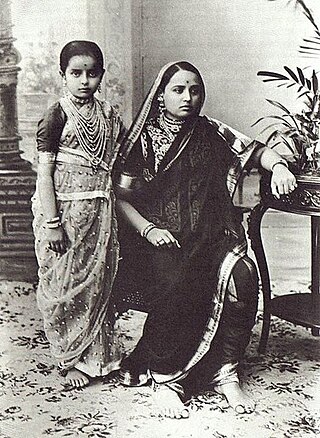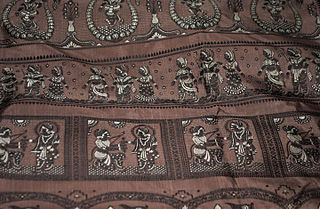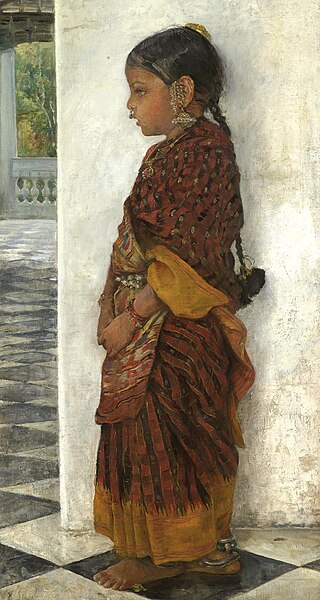Related Research Articles

A sari is a women's garment from the Indian subcontinent, that consists of an un-stitched stretch of woven fabric arranged over the body as a robe, with one end attached to the waist, while the other end rests over one shoulder as a stole (shawl), sometimes baring a part of the midriff. It may vary from 4.1 to 8.2 metres in length, and 60 to 120 centimetres in breadth, and is form of ethnic wear in India, Sri Lanka, Nepal, Bangladesh and Pakistan. There are various names and styles of sari manufacture and draping, the most common being the Nivi style. The sari is worn with a fitted bodice also called a choli and a petticoat called ghagra, parkar, or ul-pavadai. It remains fashionable in the Indian subcontinent today.

Jamdani is a fine muslin textile produced for centuries in South Rupshi of Narayanganj district in Bangladesh on the bank of Shitalakhwa river.

A Banarasi sari is a sari made in Varanasi, an ancient city which is also called Benares (Banaras). The saris are among the finest saris in India and are known for their gold and silver brocade or zari, fine silk and opulent embroidery. The saris are made of finely woven silk and are decorated with intricate designs, and, because of these engravings, are relatively heavy.

Silk In India, about 97% of the raw mulberry silk is produced in the Indian states of Karnataka, Andhra Pradesh, Tamil Nadu and West Bengal. Mysore and North Bangalore, the upcoming site of a US$20 million "Silk City", contribute to a majority of silk production. Another emerging silk producer is Tamil Nadu in the place in where mulberry cultivation is concentrated in Salem, Erode and Dharmapuri districts. Hyderabad, Andhra Pradesh and Gobichettipalayam, Tamil Nadu were the first locations to have automated silk reeling units.

A Sambalpuri sari is a traditional handwoven bandha (ikat) sari wherein the warp and the weft are tie-dyed before weaving. It is produced in the Sambalpur, Balangir, Bargarh, Boudh and Sonepur districts of Odisha, India. The sari is a traditional female garment in the Indian subcontinent consisting of a strip of unstitched cloth ranging from four to nine meters in length that is draped over the body in various styles.

The Kanchipuram silk sari is a type of silk sari made in the Kanchipuram region in Tamil Nadu, India. These saris are worn as bridal & special occasion saris by most women in Tamil Nadu, Kerala, Karnataka & Andhra Pradesh. It has been recognized as a Geographical indication by the Government of India in 2005–2006.

Baluchari Sari is a type of sari, a garment worn by women in Bangladesh and Indian states of West Bengal, Tripura and Assam. This particular type of sari originated in West Bengal and is known for depictions of mythological scenes on the anchal of the sari. It used to be produced in Murshidabad but presently Bishnupur and its surrounding areas of West Bengal are the only place where authentic Baluchari saris are produced. It takes approximately one week to produce one such sari. In 2011, the Baluchari Sari was granted the status of Geographical Indication for West Bengal in India.

The Chanderi sari is a traditional Koli sari made in Chanderi, Madhya Pradesh, India.

Pochampally sari or Pochampalli ikat is a saree made in Bhoodan Pochampally, Yadadri Bhuvanagiri district, Telangana State, India. They have traditional geometric patterns in "Paagadu Bandhu" (Ikat) style of dyeing. The intricate geometric designs find their way into sarees and dress materials. The Indian government's official airplane company, Air India, has its cabin crew wear specially designed Pochampally silk sarees.
Venkatagiri Sari is a sari style woven in Venkatagiri of Tirupati district in the Indian state of Andhra Pradesh. It was registered as one of the geographical indication from Andhra Pradesh by Geographical Indications of Goods Act, 1999. Venkatagiri saris are known for their fine weaving. These style of saris can also be found in the villages of Sengunthapuram, Variyankaval, Elaiyur, Kallathur, Andimadam and Marudhur villages.
Kovai Cora cotton or Kovai Kora cotton is a type of saree made in the Coimbatore region in Tamil Nadu, India. It has been recognized as a Geographical indication by the Government of India in 2014–15. The Devanga community are pioneers in weaving Kovai Kora cotton saris. 82 Weaver cooperative Societies in Coimbatore, Tiruppur and Erode are authorised to sell Kovai Kora cotton saris.

Handloom saris are a traditional textile art of Bangladesh and India. The production of handloom saris is important for economic development in rural India.
Mangalagiri Sarees and Fabrics are produced by performing handicraft weaving in Mangalagiri, a town in Guntur district of the Indian state of Andhra Pradesh. It was registered as one of the handicraft in the geographical indication from Andhra Pradesh by Geographical Indications of Goods Act, 1999.

Dharmavaram handloom pattu sarees and paavadas are textiles woven by hand with mulberry silk and zari. They are made in Dharmavaram of Anantapur district in the Indian state of Andhra Pradesh. It was registered as one of the geographical indication from Andhra Pradesh by Geographical Indications of Goods Act, 1999.

Habaspuri is a cotton-based traditional handloom textiles of Odisha, India. Habaspuri sari is a major product of this textile. The Bhulia weavers of Chicheguda, Kalahandi district, Odisha are originally attributed for weaving of the Habaspuri fabric. For its uniqueness in weaving, design and production, it has been identified as one of the 14 Geographical Indications of Odisha.

Odisha Ikat, is a kind of ikat known as Bandhakala and Bandha, a resist dyeing technique, originating from Indian state of Odisha. Traditionally known as "Bandhakala"', "Bandha", '"Bandha of Odisha", it is a geographically tagged product of Odisha since 2007. It is made through a process of tie-dyeing the warp and weft threads to create the design on the loom prior to weaving. It is unlike any other ikat woven in the rest of the country because of its design process, which has been called "poetry on the loom". This design is in vogue only at the western and eastern regions of Odisha; similar designs are produced by community groups called the Bhulia, Kostha Asani, and Patara. The fabric gives a striking curvilinear appearance. Saris made out of this fabric feature bands of brocade in the borders and also at the ends, called anchal or pallu. Its forms are purposefully feathered, giving the edges a "hazy and fragile" appearance. There are different kinds of bandha saris made in Odisha, notably Khandua, Sambalpuri, Pasapali, Kataki and Manibandhi.
Brahmapuri Patta saree is registered under the Geographical Indications (GI) of Goods Act by Government of India. The "sari" meant for women and the "joda" meant for men. For this famous silk work, Brahmapur is also known as silk city of India.

Tangail saree is a traditional handwoven saree (Sari) of West Bengal. It is produced in Purba Bardhaman & Nadia districts of West Bengal. These handlooms are famous for the novelty of saree designs, hand-woven booties, use of natural fibers in the weave and saree fineness of the fabric. In 2024, Tangail Saree was recognized as a Registered Geographical Indication under the title Tangail Saree of Bengal and Banglar Tangail Saree in Bengali language.

Tangail saree is a traditional handwoven saree of Bangladesh. Its origin is Tangail district of the country. A different form of the saree is also popular in West Bengal, India.

Shantipur Handloom Industry, also known Shantipur Handloom Cluster, is a handloom weaving industry in Nadia district of West Bengal. It is one of the foremost handloom centers of India. This handloom industry is world famous for the production of cotton Sari (saree). The two main centers of this industrial zone are Shantipur and Phulia. Shantipur has an old reputation for cotton sarees, known as Shantipuri sarees, and Phulia is well known for Tangail-Jamdani sarees.
References
- ↑ "Geographical Indication". The Hans India. 23 January 2016. Retrieved 27 January 2016.
- ↑ "Registration Details of Geographical Indications" (PDF). Intellectual Property India, Government of India. Retrieved 14 May 2019.
- ↑ Jemima Margaret Eliot (30 December 2008). "Andhra spin! - The Times of India". The Times of India. Retrieved 27 January 2016.
- 1 2 3 4 Vasudev, Shefalee. "Next-Gen Weavers: Jamdani of the south". Livemint. Retrieved 28 January 2016.
- ↑ "AP Jamdani sarees get GI recognition – Rediff.com Business". www.rediff.com. Retrieved 28 January 2016.
- 1 2 3 10టీవీ, బృందం. "కళ కోల్పోతున్న చేనేత కార్మికులు". 10tv.in. Archived from the original on 8 September 2015. Retrieved 5 February 2016.
{{cite web}}: CS1 maint: numeric names: authors list (link) - ↑ "Gorgeous Gadwal". Deccan Herald. Retrieved 28 January 2016.